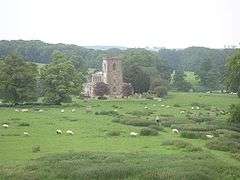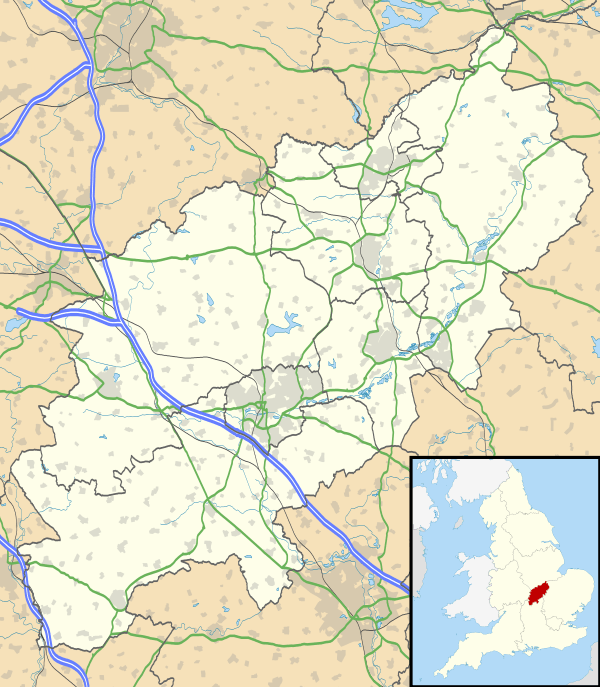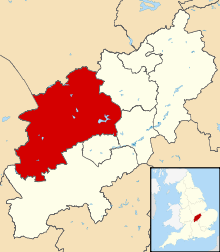Fawsley
| Fawsley | |
 St Mary's church, viewed from Fawsley Hall |
|
 Fawsley |
|
| OS grid reference | SP5657 |
|---|---|
| District | Daventry |
| Shire county | Northamptonshire |
| Region | East Midlands |
| Country | England |
| Sovereign state | United Kingdom |
| Post town | Daventry |
| Postcode district | NN11 |
| Dialling code | 01327 |
| Police | Northamptonshire |
| Fire | Northamptonshire |
| Ambulance | East Midlands |
| EU Parliament | East Midlands |
| UK Parliament | Daventry |
|
|
Coordinates: 52°12′46″N 1°10′28″W / 52.2128°N 1.1745°W
Fawsley is a hamlet and civil parish in the Daventry district of the county of Northamptonshire, England.[1] The population at the 2001 census was 32. At the 2011 census the population remained less than 100 and is included in the civil parish of Charwelton.
The Domesday Book (1086) confirms the population of Fawsley (Falelau) as around 50, but the Knightley family of Fawsley Hall developed the sheep farming at the expense of their peasant tenants, who were all evicted by the turn of the 15th century. The hall and the church are all that remain of Fawsley.
Fawsley Hall
Fawsley Hall and landscape park was created by the Knightley family. Richard Knightley, a well-to-do Staffordshire lawyer, bought the manor of Fawsley in 1416. His grandson Richard, knighted by Henry VII, built the first wing of the present house.[2]

Sir Richard's son, Sir Edmund Knightley, was a commissioner concerned with the confiscation of monastic lands after the Dissolution of the Monasteries. King Henry VIII granted the manors of Badby and Newnham in 1542 to Sir Edmund Knightley and his wife Ursula and their heirs in exchange for Alderton and Stoke. Sir Edmund ordered the building of the Elizabethan hall, which was visited by Elizabeth I in 1575, after it had passed to Edmund's nephew, Richard Knightley, a prominent Puritan. He ran a secret printing press at the house on which were printed Puritan pamphlets and for which he was briefly imprisoned.
The dower house in Fawsley Park, last inhabited in 1704 and now in ruins, was built for Lady Ursula after Sir Edmund died. It was placed on the Heritage at Risk register by English Heritage in 2014. The Fawsley Estate has been working with English Heritage and Natural England to prepare a comprehensive scheme of historic landscape restoration. Some stabilisation of the ruins is being undertaken.[3]
The estate descended in the wider Knightley family, many of them Members of Parliament, to Mr Lucy Knightley, who inherited in 1728 and built the Georgian wing of Fawsley Hall. Lucy was High Sheriff of Northamptonshire for 1770–71.
In 1798 Sir John Knightley was created a Baronet. His nephew, Sir Charles Knightley, 2nd Baronet, carried out the Gothic alterations to the Georgian Wing, and his son Sir Rainald, the 3rd Baronet, commissioned architect Anthony Salvin to re-model the North Wing. Sir Rainald served as MP for South Northamptonshire for 40 years and was created Baron Rainald in 1892, but died childless in 1895. His widow kept possession until 1913, after which financial restraints necessitated the auction of the house's contents after her death. She was the last Knightley to live at the Hall, completing 500 years of Knightley occupation.
When her eventual heirs Sir Charles Valentine, 5th Baronet died in 1932 and his brother, Sir Henry Francis, 6th and last Baronet, died in 1938, the estate passed to the Gage family of Firle Place, Sussex, by virtue of an earlier marriage of Sir Rainald's sister, Sophia, to Viscount Gage. The Gage family still own the former Knightley lands.
Fawsley Hall is now a country house hotel and spa, owned by Hand Picked Hotels. It is one of two buildings in Fawsley listed as Grade I, the other being St Mary's Church.[4]
St Mary's church
Standing isolated on a grassy knoll and surrounded by a ha-ha, St. Mary's Church contains the Knightley family tombs including effigies of the 16th century Sir Richard Knightley and his wife Jane. Dating to the early 13th century, the church has many fine features such as carved poppy heads and stained glass thought to be from Sulgrave Manor. A considerable amount of the copper roof covering was stolen in 2015 and temporary sheeting had to be applied whilst considerable funds are amassed to replace the metal.
See also
References
- ↑ - OS Explorer Map 207: Newport Pagnell & Northampton South (1:25 000) ISBN 0319 46387 7
- ↑ "A brief summary of the history of the Fawsley estate and house starting from the 7th century through to the present day.". Retrieved 12 April 2013.
- ↑ See https://www.facebook.com/Croft-Building-and-Conservation-Ltd-167254123463119/ April 4, 2016
- ↑ See this list for all the listed buildings.
External links
![]() Media related to Fawsley at Wikimedia Commons
Media related to Fawsley at Wikimedia Commons
